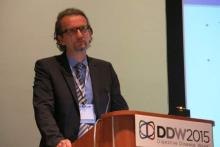WASHINGTON – The anti-MAdCAM candidate, PF-00547659, induced responses in up to 54% of patients with moderately to severely active ulcerative colitis failing at least one prior therapy.
At the optimal dose of 22.5 mg, 16.7% of all patients and 25.8% of patients naive to anti–tumor necrosis factor (TNF) therapy achieved remission with the anti-mucosal addressin cell adhesion molecule 1 (MAdCAM-1) monoclonal antibody in the phase II TURANDOT trial, Dr. Walter Reinisch reported in a late-breaking abstract session at the annual Digestive Disease Week.
Selective blockade of adhesion molecules is an attractive treatment strategy for inflammatory bowel disease, with one approach shown to improve clinical outcomes by blocking alpha4beta7 integrin. Drugs that bind to alpha4beta7 include the ulcerative colitis (UC) drug vedolizumab (Entyvio), the experimental UC drug etrolizumab, and the Crohn’s disease and multiple sclerosis drug natalizumab (Tysabri).
Natalizumab, which also binds to alpha4beta1 integrin on endothelial cells expressing VCAM-1, however, has raised concerns because it increases the risk of progressive multifocal leukoencephalopathy (PML), a rare and fatal viral infection of the brain.
PF-00547659 has no cross-reactivity with vascular cell adhesion proten-1 (VCAM-1) and has no effect on central nervous system immune surveillance, said Dr. Reinisch of McMaster University, Hamilton, Ont.
The phase II double-blind TURANDOT trial randomly assigned 357 patients with moderate to severe UC who had failed or were intolerant to at least one conventional therapy to one of four doses of PF-00547659 (7.5 mg, 22.5 mg, 75 mg, or 225 mg) or placebo delivered by subcutaneous injection in three doses separated by 4 weeks. The primary endpoint was clinical remission, defined by a total Mayo Score at week 12 of ≤ 2 points with no individual subscore > 1. More than half of patients had received prior anti-TNF therapy, the average baseline total Mayo Score was 8.4, and average age was 40 years.
Clinical remission rates followed a bell-shaped curve, occurring in 2.7% of patients on placebo, 11.3% on PF-00547659 at the 7.5-mg dose, 16.7% at 22.5 mg, 15.5% at 75 mg, and 5.7% at 225 mg. The difference between placebo and active treatment was statistically significant at a P value of less than .05 for all but the 225-mg dose, Dr. Reinisch reported.
Clinical responses were seen in 28.8%, 38%, 54.2%, 45%, and 50% of patients, respectively, with the three highest PF-00547659 doses achieving significance (P values < .05).
Compared with placebo, mucosal healing was significantly more common at the 22.5-mgdose (8.2% vs. 27.8%; P < .05) and 75-mg dose (8.2% vs. 25.4%; P < .05) and trended higher for the 7.5-mg dose (15.5%) and 225-mg dose (14.3%).
Mucosal healing may be driving the bell-shaped dose-response curve, but additional analyses are ongoing to determine whether the curve is a robust finding, he said.
Fetal calprotectin declined in all treatment groups versus placebo, with the nadir reached at week 8 and maintained.
No major differences in safety signals between placebo and active treatment were seen, including infections (18% vs. 21%), GI infections (1% vs. 4%), and infections in ex-GI MAdCAM bearing tissues (7% vs. 6%), Dr. Reinisch said.
During a discussion of the findings, concerns were raised about a theoretical risk for PML akin to natalizumab because MAdCAM is not that specific. Dr. Reinisch repeated that there’s no evidence to suggest this, and cited a vedolizumab trial showing no PML in patients with Crohn’s disease (N. Engl. J. Med. 2013;369:711-21).
Dr. Reinisch disclosed ties with several drug companies, including Pfizer, which sponsored the study.
On Twitter @pwendl


